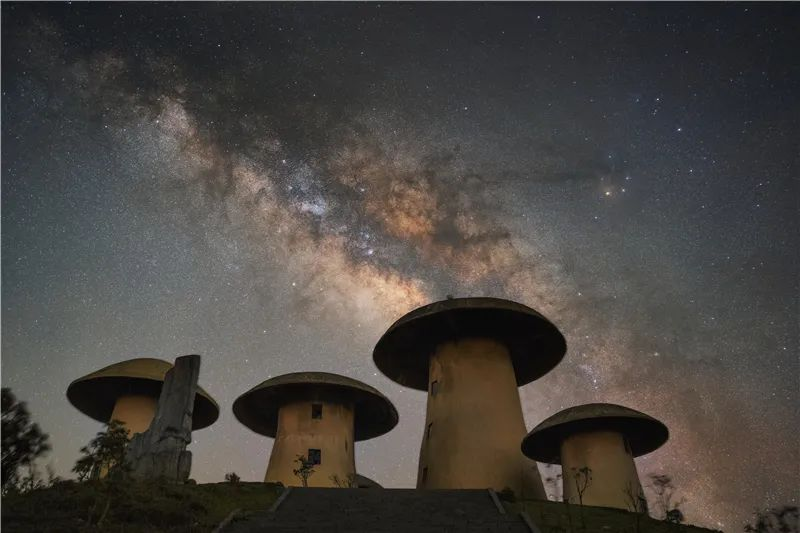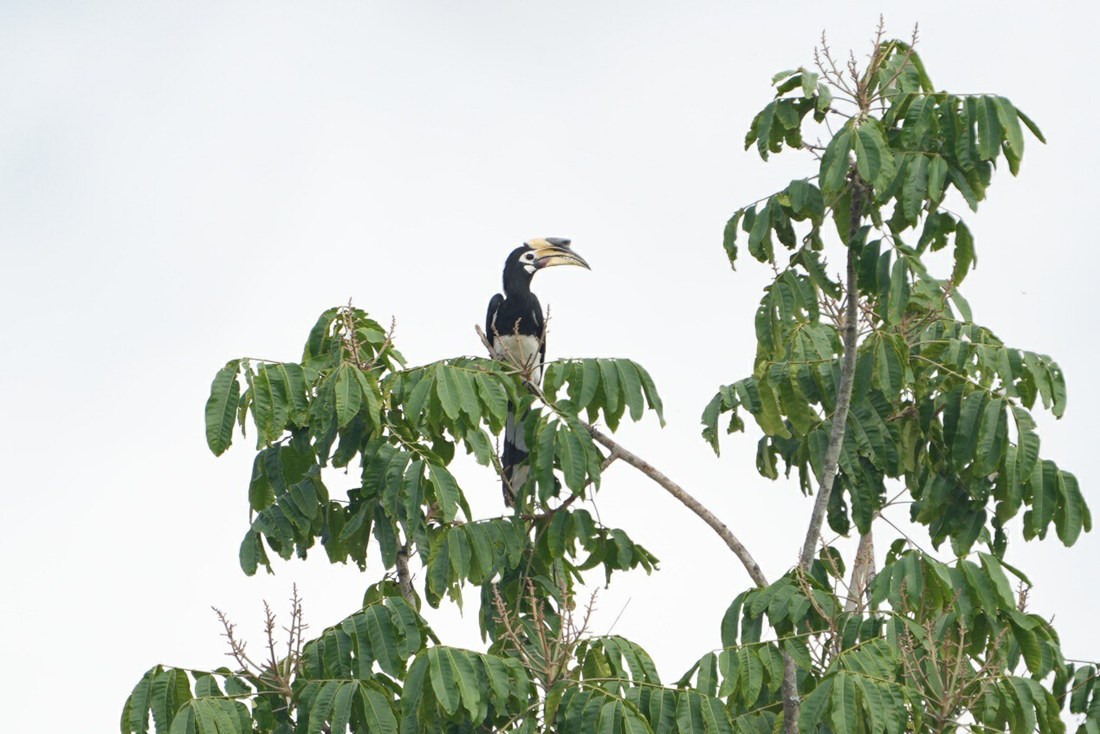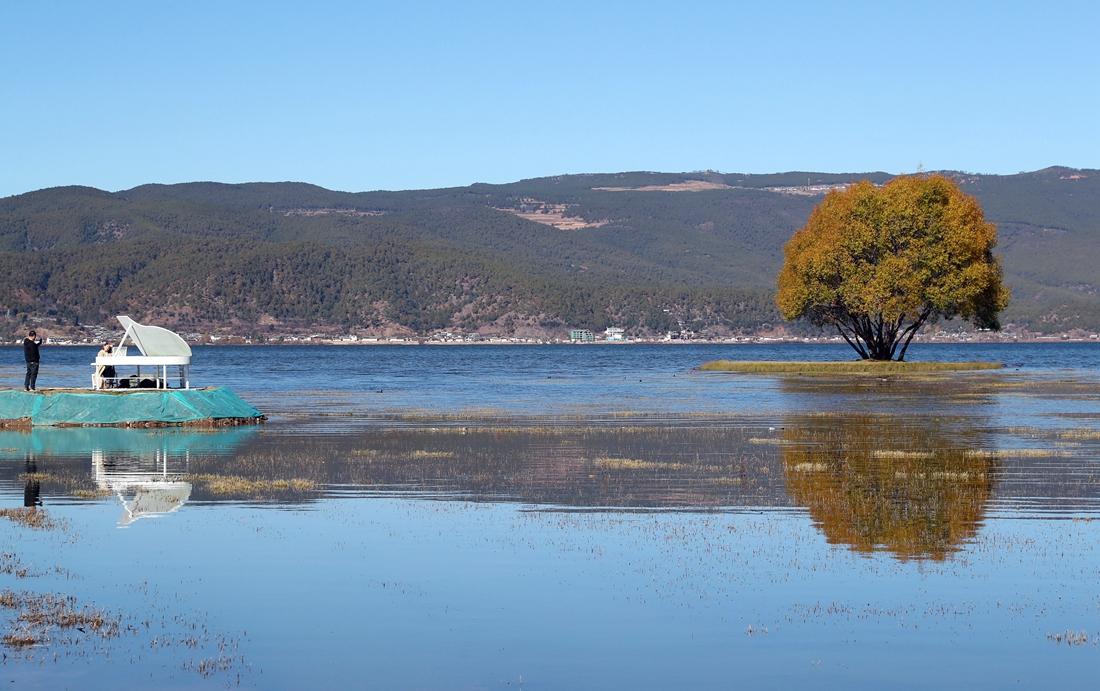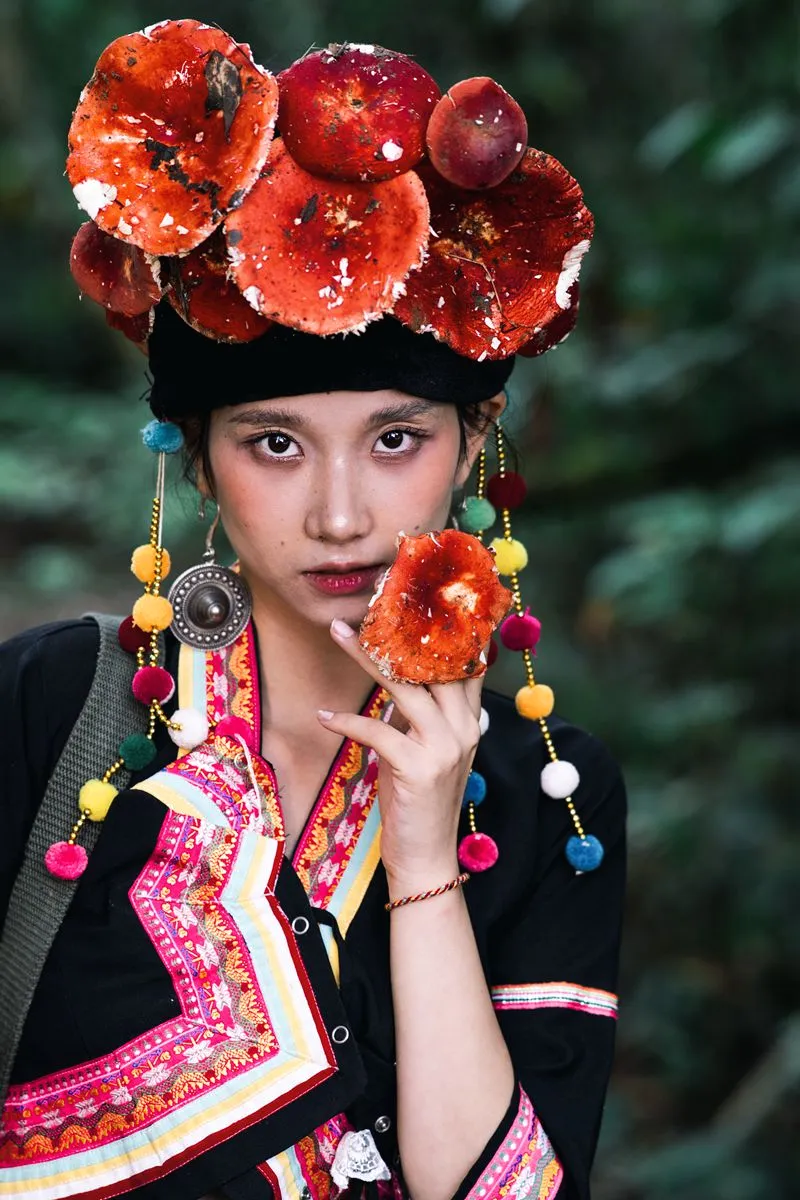Yunnan: a living natural photo studio
Yunnan, renowned for its unmatched natural beauty and rich cultural heritage, is often referred to as a natural photo studio, attracting countless movies and TV dramas for filming. Whether you are a professional photographer, a photography enthusiast, or simply a tourist, Yunnan offers endless creative inspiration to capture heartwarming moments. Here, the camera narrates stories through light and shadow.

Embarking on an astrophotographic journey
In the center of the photo, the Milky Way stretches vertically, casting a stunning and romantic light band made up of countless stars that illuminates the dark night. Covering less than one-eighth of the image, the ground features a blend of a barren slope and a lush green field. Two figures in graduation gowns stand at the boundary between these two landscapes, their backs to the viewer as they jointly hold an oil lamp, gazing up at the night sky.
This photo, titled “Graduation Photo Under the Starry Sky,” was captured by Ying Haofei, a young man born after 2000. In 2022, as he graduated from university, Ying and his high school classmate Zhang Zhaohai gathered their friends in Xundian County, Kunming City, to take this stunning graduation photo using astrophotography techniques. With the dark starry sky as the backdrop and a recognizable ground landscape, Ying used ultra-wide-angle and medium focus techniques, along with long exposure, time-lapse, splicing, and color mixing, to enhance the brightness of the stars. The result is an image that beautifully highlights the starry sky as its focal point.
Yunnan is situated on a plateau, where the high altitude contributes to excellent air permeability and a significant number of clear days, coupled with the dark night skies found in western regions away from urban areas. These conditions create an ideal environment for astrophotography. In recent years, the increasing availability and affordability of photographic equipment, including smartphones, have made astrophotography more accessible than ever. This trend has led to a surge in astrophotographic images featuring Yunnan, attracting increased attention on social media.
Like many astrophotographers, Ying and Zhang are relatively new to the field. “In 2019, I came across a video on Bilibili featuring a starry sky that a content creator had spent three years capturing. That video amazed me and reignited the passion for the night sky I had developed from reading extracurricular books in elementary school. So, at the beginning of 2020, I bought a full-frame camera and officially began my astrophotographic journey,” Zhang shared.
In just a few years, Ying and Zhao have explored all corners of Yunnan Province. Through their lenses, they have captured stunning scenes, including the star-lit rice terraces in Yuanjiang, the mushroom-shaped buildings on Junzi Mountain in Shizong, glowing fireflies at the Botanical Garden of the Chinese Academy of Sciences, the “Eye of the Galaxy”—a bridge hole near Erhai Lake, the path of a total lunar eclipse at Gaozhuangxishuangjing, and fleeting meteors over the Honghe River valley.
Injuries, falls, and hurried moments—setbacks on the path of astrophotography are all too common for them. However, because it is a labor of love, every struggle feels worthwhile. “The starry sky is like a steadfast, beloved old friend or a lofty and unfathomable sage. Even if we visit the same place countless times, it feels like we’re unboxing a surprise each time. We will continue our journey, committed to capturing the most beautiful starry skies in Yunnan,” Ying and Zhang said resolutely.

Setting off on an eco-photography adventure
Just a few days ago, in a bamboo grove at an altitude of 2,700 meters in Fengqing County, Yunnan Province, an oddly shaped bird was perched on the moss, foraging for food. With a beak resembling a slender hook, it hopped among the dense foliage. Nearby, a young man raised his camera, and with a click of the shutter, he captured the first recorded sighting of a new subspecies of the rufous-necked hornbill (Pomatorhinus ruficollis) in China.
The young man, Zhao Haixuan, is a professional birdwatcher based in Lincang. During this expedition, he documented six rufous-necked hornbills of the new subspecies, a discovery that helps fill a gap in the known subspecies of rufous-necked hornbills in China. With years of experience in bird photography, Zhao has encountered 456 different bird species, capturing their stories through his lens.
Yunnan, often referred to as the Kingdom of Animals, the Kingdom of Plants, and the Gene Pool of Species, is the most biodiverse province in China. For each species found in Yunnan, the population of that species is nearly equal to or exceeds half of the total population of that species across the country. This rich biodiversity offers limitless creative inspiration and opportunities for eco-photography. Notably, Yunnan hosts a considerable number of rare birds, boasting over 1,000 bird species, which represents more than two-thirds of China’s avian diversity and 9% of the world’s total bird species.
The Nujiang area of the Gaoligong Mountains National Nature Reserve is the largest nature reserve in Yunnan Province and one of the most critical regions for global biodiversity conservation, boasting a remarkable array of biodiversity that is rarely seen elsewhere in the world. As a result, academics often refer to it as “the world’s gene pool of species.” Wang Bin, 52, has dedicated the past 29 years to nature conservation. Throughout this time, he has utilized photos and videos to document and protect the diverse life forms in the Gaoligong Mountains. His work includes capturing rare species such as the white-bellied heron, Myanmar snub-nosed monkey, Sclater’s monal, gaur, Chinese yew, and giant rhododendron, along with a wealth of stunning photographs showcasing the region’s natural landscapes.
“I plan to compile an atlas featuring 300 wild flowering plant species in the Nujiang River Basin. We can’t keep our research results confined to the computer; we need to raise awareness about the Gaoligong Mountains through this atlas to enhance its protection,” Wang said.
“I once encountered the extremely rare Hooker’s snowdrop in the snowy mountains at an altitude of 4,900 meters. Its tiny flowers, ranging from blue to purple, are connected like a carpet. The moment I saw it, tears flowed uncontrollably,” said Fan Yi, a biodiversity photography expert in China and vice president of the Yunnan Society for Promotion of Natural and Cultural Heritage Protection.
Yunnan is home to over 19,000 species of higher plants. Fan Yi, a native of Kunming, grew up immersed in the world of plants, capturing their portraits along the way. After more than a decade of exploring the mountains and waters of Yunnan, he has gained unique life experiences and insights that most people may never encounter. This profound understanding is the gift that the region’s landscapes have bestowed upon him.
From June to August each year, Fan focuses his efforts on fieldwork. During this time, his sole purpose is to venture into the mountains in search of rare plateau plants. He has been pleasantly surprised by countless remarkable encounters along the way.
Hooker’s snowdrop is a mat-like plant species belonging to the Boraginaceae family. To catch a glimpse of this rare flower, Fan and his teammates traveled to Diqing Zang Autonomous Prefecture in northwestern Yunnan and climbed to an altitude of 4,900 meters on Baima Snow Mountain. By the time they finally discovered it, they had pushed themselves to their physical limits. Upon seeing the blooming Hooker’s snowdrop, which felt like a heavenly reward, their tears flowed freely.
Fan believes that using photography to narrate the story of biodiversity, while also creating artistic photos and videos, represents the future of biodiversity conservation and development. “Sharing the message about these living creatures hidden deep within Yunnan’s mountains is a demonstration of respect and love for Yunnan’s natural beauty,” he said.

Eternalizing the splendor of mountains and rivers
Yunnan’s terrain extends from towering snow-capped mountains in the north to lush tropical rainforests in the south, and from patchwork rice terraces in the east to the breathtaking depths of treacherous canyons in the west. With its rich and vibrant natural landscapes, Yunnan has become a magnet for photographers, who journey across its countless mountains and rivers to capture the fleeting interplay of light and shadow.
“Lijiang holds a special place in my heart. I used to visit every year for both business and sightseeing. The mountains, rivers, grass, and trees here deeply captivate me,” said Jiang Ke, a photographer born in the 1980s, reflecting on his emotional connection to Lijiang.
In Jiang’s view, Lijiang is a place where stunning natural scenery and rich cultural heritage coexist, making it an enticing destination for exploration. “Not only is there the Jade Dragon Snow Mountain, which, despite being near the equator, is capped with snow year-round, but there are also vast expanses of untouched forests and vibrant local cultures. Additionally, the area boasts natural wonders such as Haba Snow Mountain, the Jinsha River, and Tiger Leaping Gorge, all within easy reach,” said Jiang.
“Perhaps only majestic mountains and beautiful waters can create a paradise. Lijiang is not only home to Jade Dragon Snow Mountain, but it is also bordered by the Jinsha River. The remarkable individuals from this region have added to its glory,” Jiang said. He aspires to showcase more than just the beauty of Lijiang. “For me, Lijiang holds countless surprises waiting to be discovered and documented.”
The sea of rapeseed flowers in Luoping is a true symbol of spring. From February to March each year, vast fields of rapeseed bloom in Luoping County, Qüjing City, Yunnan Province, creating a stunning landscape. The golden flowers, resembling a vast sea, draw many photography enthusiasts to the area. In 2002, the rapeseed fields of Luoping were recognized by the Guinness Book of World Records as “the world’s largest natural garden.”
Each photograph of the sea of rapeseed flowers captured by photographer Mao Hong is beautiful in its own unique way. When Mao first began photographing rapeseed flowers, the scale of planting in Luoping was nowhere near what it is today; only dedicated photographers, equipped with various cameras, would venture out to the fields. These passionate flower enthusiasts gradually attracted numerous visitors who came to appreciate the blossoms. Over time, Luoping gained fame for its rapeseed flowers, yet the local cultivation remained limited, leaving many who traveled long distances to enjoy the blooms feeling a bit disappointed.
The rivers and lakes in Yunnan are also photographic hit spots. Jinsha River, Lancang River, Nujiang River, Dulongjiang River, Nanpanjiang River, Yuanjiang River and other big rivers flowing through Yunnan, each of which has a unique scenery. Moreover, Yunnan is abundant in natural plateau lakes, with nine of them covering an area of over 30 square kilometers. “The wind of Xia Guan, the flowers of Shang Guan, the snow of Cangshan Mountain, the moon in Erhai Lake” in Dali, the magnificent landscapes of Chengjiang in Yuxi, the various meteorological phenomena of Dianchi Lake in Kunming, the enchanting fairyland of Lugu Lake in Lijiang……Each lake here presents a splendid and unique landscape.

Donning ethnic costumes for an unforgettable travel experience
Recently, China’s domestic suspense TV series “Once Upon a Time in Sanbianpo” has been released online, captivating numerous viewers with its thrilling plot. Set against the backdrop of Southeast Asia, the series features villages, fairs, and tropical rainforests, particularly showcasing the Xishuangbanna Dai Autonomous Prefecture in Yunnan. As a so-called natural photo studio, Yunnan offers endless creative inspiration and filming opportunities, while also drawing tourists to experience its unique cultural customs and ethnic diversity.
Yunnan, with its rich ethnic culture, is home to 26 ethnic groups, and the vibrant customs of these communities contribute to the region’s cultural diversity and richness. If Yunnan’s natural scenery and ethnic culture represent the soul of this land, then its traditional costumes serve as the outward expression of that soul. From Yi embroidery and Bai tie-dye to Dai tube skirts and Miao silver jewelry, each piece of ethnic clothing reflects the artisan’s skill and dedication. These unique garments are experiences that no tourist should miss on their journey through Yunnan.
As night falls and the lights come on, stepping into the walled city of Dali reveals tourists from across the country dressed in various ethnic costumes as they navigate the streets and alleys. The sound of shutters captures moments that hold their unique memories of Dali. During their journey, visitors not only enjoy an immersive travel experience but also create stunning photos. Travel photography has gradually become an essential activity for many tourists.
Travel photo shops in the walled city of Dali welcome a steady stream of tourists looking to book night shoots. Here, makeup artists and stylists tailor their looks to meet the individual preferences of each visitor. The shops offer hundreds of ethnic costumes for customers to choose from, along with a variety of shooting packages, providing tourists with plenty of options. “Travel photography in Dali is a wonderful way to experience the local customs, and you can enjoy a wide range of beautifully crafted ethnic costumes,” said Wang Siyu, a tourist from Beijing.
Mangshi, a small border town in Yunnan, is a fantastic destination for experiencing ethnic customs. Wearing Dai costumes and capturing beautiful images against the backdrop of landmark structures like the Golden Pagoda and the Silver Pagoda in Menghuan makes visitors feel as though they have stepped into Southeast Asia, immersing them in the unique charm of its exotic culture.
Zhang Ajin, a tourist from Xi’an City in Shaanxi Province, was drawn to Yunnan’s cool summer climate and decided to visit Mangshi with her family. “I chose Mangshi for travel photography because these costumes are hard to find elsewhere. The outfits I selected today are colorful and distinctly ethnic. They are breathable, cool, and stylish, with intricately embroidered collars and cuffs. I’m very satisfied with my choice,” she said.
What happens when Yunnan’s wild mushrooms are combined with ethnic clothing? Recently, a photographer in Pu’er City, Yunnan Province, created a stunning series of artistic photos featuring wild mushrooms alongside Bulang ethnic clothing and traditional hairpins. This creative approach breathes new artistic life into the vibrant red mushrooms, transforming them into striking headpieces for Bulang girls. This unique photo collection showcases the distinctive charm of Yunnan, allowing tourists to capture beautiful moments in nature while also highlighting the delicacy and creativity that leave a lasting impression.
Text by our staff correspondents
Translated by YNTA